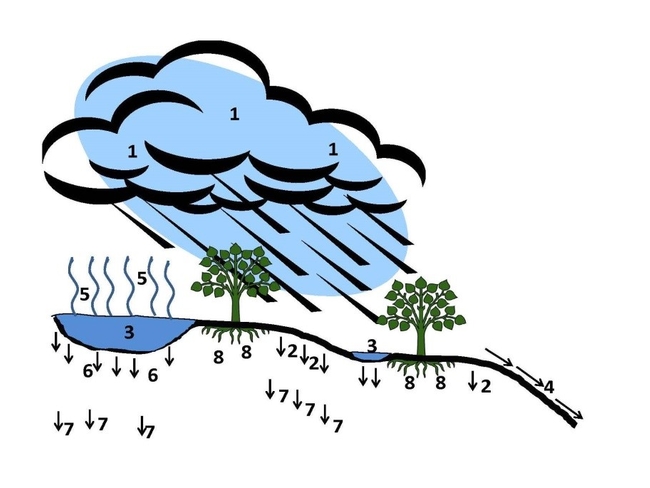Capturing Precipitation - How much rainfall do I need to capture?
Managing precipitation to your advantage is really a three step process (Lal and Stewart, 2012).
ü Step 1 - maximize preciptitation captured in the soil
ü Step 2 - minimize the evaporation of the stored soil moisture
ü Step 3 - maximize plant water use efficiency
The first step of the process is often thought of as “effective rain”. Effective rainfall refers to the percentage of rainfall which becomes available to plants and crops. It considers “losses” due to runoff, evaporation and deep percolation (Klein, 2011). In the past we might have considered deep percolation as a loss. We now know that percolation “losses” may be a vital resource in sustaining our groundwater basins. As we move into the fall of 2015, we have the opportunity to plan for effective rainfall by managing the orchard floor for maximum capture of precipitation. This will help provide stored soil moisture for plant growth as well as deep percolation of water to groundwater
The following figure illustrates some of the important points about effective rainfall and reminds us of what we can do to maximize capture of precipitation (1). We want to maximize 2 (infiltration during a rain event), 3 (surface capture), 6 (infiltration from surface capture), 7 (percolation to ground water), and 8 (rootzone storage for use by the crop). We want to minimize 4 (runoff) and 5 (evaporation).
When rain water ((1) falls on the soil surface, some of it infiltrates into the soil (2), some stagnates on the surface (3), while some flows over the surface as runoff (4). When the rainfall stops, some of the water stagnating on the surface (3) evaporates to the atmosphere (5), while the rest slowly infiltrates into the soil (6). From all the water that infiltrates into the soil ((2) and (6)), some percolates below the rootzone (7), while the rest remains stored in the rootzone (8). From FAO Irrigation Water Management 1985 http://www.fao.org/docrep/r4082e/r4082e05.htm#4.1.4 effective rainfall
Larry Stein from Texas A&M wrote a very good basic explanation “So What Constitutes an Effective Rain Event ?” (Stein, 2011) We can use his approach to look at managing precipitation in the Central Coast. Understanding these concepts can help you manage precipitation in your operation.
For example, the majority of olive roots are in the top 18 inches of soil. So how much rainfall do we need to capture to refill the rootzone of an olive grove in Paso Robles? We need to know:
ü The amount and intensity of rainfall
ü The infiltration rate of the soil (how fast the soil takes in water). Sandy soils take water in more quickly.
ü How much water the soil will hold in the rootzone of the grove
Average rainfall for Paso Robles in January is about 2.75 inches. Table 1 shows that olives on a sandy loam soil might be able to infiltrate 1 to 1.5 inches per hour. If all that rain comes in one storm then as much as 1.25 inches may either run off (4) or pond (3) in the low spots until it can infiltrate.
Average rainfall in Paso Robles in January would be adequate to refill the rootzone of olives (8) on a sandy loam soil, IF all of the rainfall infiltrates (2), and none is lost to evaporation (5) or runoff (4).
Table 1. General soil water storage and depletion characteristics for three different soil types (Klein, 2011)
|
|
Soil Texture |
||
|
|
Sands |
Loams |
Clays |
|
Water infiltration rate (inches / hour) |
2.0 – 6.0 |
0.6 – 2.0 |
0.2 – 0.6 |
|
Available water (inches / foot) |
1.0 – 1.5 |
1.5 – 2.5 |
2.5 – 4.0 |
|
Days to depletion when ET – 0.2 inches / day |
5 – 7.5 |
7.5 – 12.5 |
12.5 – 20.0 |
|
Amount of water to wet to 18 inches in a dry soil (inches) |
1.5 |
2.25 – 3.0 |
3.75 |
Cover crops help keep the soil surface from crusting as well as protecting the soil surface from erosion. Their roots provide channels for water to infiltrate into the soil. Remember that cover crops may also be using water stored in the rootzone (8). When facing drought conditions, it may be advantageous to manage with low residue cover crops to reduce the amount of water extracted from the rootzone. Here's a link to a video on low residue cover crops and their impact on runoff from work by UC Cooperative Extension Advisors in Monterey County https://www.youtube.com/watch?v=k0oVVJ_BA7s
Klein, L. 2011. So What Constitutes an Effective Rain Event? http://aggie-horticulture.tamu.edu/earthkind/drought/drought-management-for-commercial-horticulture/so-what-constitutes-an-effective-rain-event/ .
Lal. R.and, B.A. Stewart. 2012. Soil Water and Agronomic Productivity
Attached Images:
